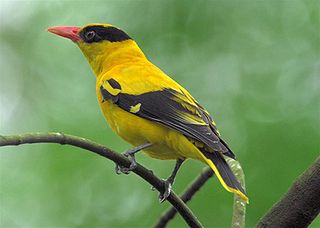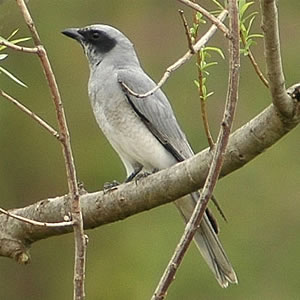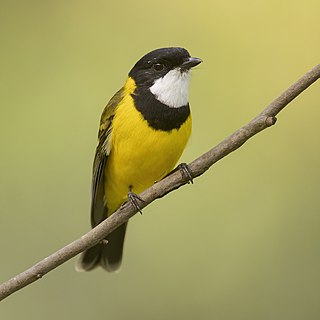
Orioles are colourful Old World passerine birds in the genus Oriolus, the type genus of the corvoidean family Oriolidae. They are not closely related to the New World orioles, which are icterids that belong to the superfamily Passeroidea.

The Old World orioles (Oriolidae) are an Old World family of passerine birds. The family contains 41 species which are divided in 4 genera. The family includes two extinct species from New Zealand that are placed in the genus Turnagra.

The cuckooshrikes and allies in the family Campephagidae are small to medium-sized passerine bird species found in the subtropical and tropical Africa, Asia and Australasia. The 93 species are divided into 11 genera. The woodshrikes (Tephrodornis) were often considered to be in this family but are now placed in their own family, Vangidae, along with the philentomas and the flycatcher-shrikes. Another genus, Chlamydochaera, which has one species, the black-breasted fruithunter, was often placed in this family but has now been shown to be a thrush (Turdidae).

Neotropical bellbird is the common name given to passerine birds of the genus Procnias, found in the Neotropics. They are members of the cotinga family. They are all restricted to tropical or subtropical humid forested regions, often in low mountains or foothills. As indicated by their common name, they all have extremely loud calls that are reminiscent of a metal bell being rung.

The Australian golden whistler or golden whistler, is a species of bird found in forest, woodland, mallee, mangrove and scrub in Australia. Most populations are resident, but some in south-eastern Australia migrate north during the winter. Its taxonomy is highly complex and remains a matter of dispute, with some authorities including as many as 59 subspecies of the golden whistler, while others treat several of these as separate species. This bird is also known as White-Throated Thickhead in older books.

Passer is a genus of sparrows, also known as the true sparrows. The genus contains 28 species and includes the house sparrow and the Eurasian tree sparrow, two of the most common birds in the world. They are small birds with thick bills for eating seeds, and are mostly coloured grey or brown. Native to the Old World, some species have been introduced throughout the world.

The friarbirds, also called leatherheads, are a groups of 18 relatively large honeyeaters in the genus Philemon. Additionally, the single member of the genus Melitograis is called the white-streaked friarbird. Friarbirds are found in Australia, Papua New Guinea, eastern Indonesia, and New Caledonia. They eat nectar, insects and other invertebrates, flowers, fruit, and seeds.

The green figbird or Timor figbird is a species of bird in the family Oriolidae. It is endemic to forest, woodland, mangrove, and scrub on the Indonesian islands of Roti and Timor. It is moderately common, so is considered to be of least concern by BirdLife International and the IUCN.

The black-and-crimson oriole is a species of bird in the family Oriolidae.

The Ethiopian oriole is a species of bird in the family Oriolidae.

The maroon oriole is a species of bird in the family Oriolidae. It is found in Southeast Asia.

Poecilotriccus is a genus of small flycatchers in the family Tyrannidae. Except for the recently described Johnson's tody-flycatcher, all have, at one point or another, been included in the genus Todirostrum. Some species have been known as tody-tyrants instead of tody-flycatchers. Most species are found in South America, but a single species, the slate-headed tody-flycatcher, is also found in Central America. The black-chested tyrant may also belong in this genus, but most place it in the monotypic genus Taeniotriccus.

The Wetar figbird is a species of bird in the family Oriolidae. It is endemic to forest, woodland and scrub on the Indonesian island of Wetar. The Wetar figbird remains poorly known, and although threatened by habitat loss, recent population estimates are greater than originally estimated, resulting in it being now listed as Least Concern by BirdLife International and the IUCN. The Wetar figbird resembles the better known Australasian figbird, but is much smaller and the male has entirely white underparts. Formerly, it has been considered a subspecies of the green figbird, but they are now classified as two separate species.

Green toucanets are near-passerine birds from the genus Aulacorhynchus in the toucan family. They are native to Mexico, and Central and South America. All are found in humid forests and woodlands in highlands, but a few also occur in adjacent lowlands. They are relatively small toucans, 30–44 centimetres (12–17 in) long, with colorful, mainly green, plumage. They are typically seen in pairs or small groups, and sometimes follow mixed species flocks.

Sturnia is a genus of Asian birds in the starling family Sturnidae. It is sometimes merged with Sturnus.

The Indian golden oriole is a species of oriole found in the Indian subcontinent and Central Asia. The species was formerly considered to be a subspecies of the Eurasian golden oriole, but is now considered a full species. Adults can be told apart from the Eurasian golden oriole by the black of the eye stripe extending behind the eye.

The Australasian figbird, also known as the green figbird, is a conspicuous, medium-sized passerine bird native to a wide range of wooded habitats in northern and eastern Australia, southern New Guinea, and the Kai Islands. It is common in large parts of its range, and occurs in numerous protected areas. Consequently, it is rated as least concern by BirdLife International and the IUCN.

Microcarbo is a genus of fish-eating birds, known as cormorants, of the family Phalacrocoracidae. The genus was formerly subsumed within Phalacrocorax.

Pitohui is a genus of birds endemic to New Guinea. The birds formerly lumped together as pitohuis were found by a 2008 study that examined their evolutionary history on the basis of the genetic sequences to have included birds that were quite unrelated to each other. They have since been separated into other genera.

Larvivora is a genus of small passerine birds belonging to the Old World flycatcher family Muscicapidae that occur in central and eastern Asia.





























